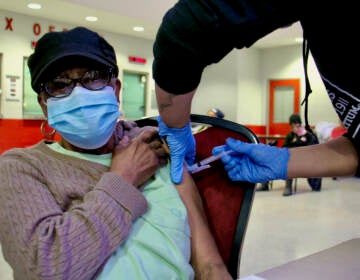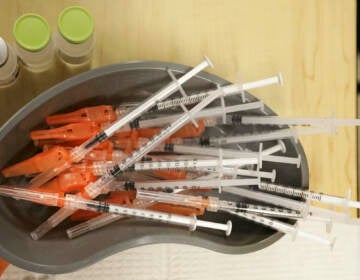Newer version of omicron variant spreads in the region. How worried should you be?
Early research from Denmark shows this type of the virus spreads more easily. But there are still a lot of questions.

A sign requiring masks as a precaution against the spread of the coronavirus is posted on a store front in Philadelphia, Wednesday, Feb. 16, 2022. (AP Photo/Matt Rourke)
A strain of the omicron variant, called B.A.2 is spreading across the U.S., including here in Pennsylvania, Delaware, and New Jersey.
Early research from Denmark found that B.A.2 spreads more easily than the initial omicron strain.
The B.A.2 type accounts for around 6 percent of virus samples in Pennsylvania, Delaware, and New Jersey, according to the latest data from the Centers for Disease Control and Prevention. It accounts for around 4 percent of virus samples nationally.
The Delaware Division of Public Health has identified fewer than 11 cases in the state as of early February. Medical Director Dr. Rick Hong said his team is monitoring the situation as they do for all variants.
Kyle Rodino, assistant professor of clinical pathology and laboratory medicine at the University of Pennsylvania, described B.A.2 as “a flavor of omicron.”
He works on a team that does genetic studies of virus samples to figure out the type of variant.
Different variants emerge as viruses mutate. Right now, researchers don’t know whether the mutations in the B.A.2 flavor make it that much different from the other flavors of the omicron variant.
The most pressing questions are: will this variant lead to more severe cases of COVID-19? Will this variant spread more quickly than the other ones?
Rodino says the good news is that the answer is probably not, based on the very early research from places like South Africa, the U.K., and other countries dealing with this particular variant.
“If we think of the sub-lineages as flavors of these different variants, during the delta wave, there are actually hundreds of delta sub-lineages from the initial delta lineage. …We didn’t see at all new peaks driven by each individual sub-lineage,” he said. “The early data is supporting what we’re hoping for — this is simply a change in the dominant sub-lineage of omicron as viruses outcompete each other but it’s not different enough to drive a new wave of the pandemic.”
Don’t call it a “stealth variant”
Quite a few stories refer to B.A. 2 as a “stealth variant,” but Rodino said that term is misleading: B.A. 2 is not any harder to detect than the other variants.
The initial omicron strain, B.A.1 has a genetic quirk that inadvertently became an easy shortcut to figure out if a virus sample had the omicron variant, without having to do the full genetic testing. The newer strain, B.A.2 does not have this genetic quirk, therefore researchers can no longer use the shortcut. But the tests to identify the virus still work.
“Some people have said that it is a stealth variant because we no longer have this very easy and early way to assess that something is a particular lineage, B.A.2,” he said. “There’s nothing stealth about the virus, it’s completely detected just as it was in the delta era, in the alpha era, in every point of this pandemic.”
Dr. Rick Hong, from the Delaware Division of Public Health, added that the familiar prevention measures — social distancing, hand washing, getting vaccinated, wearing masks — still work.
WHYY is your source for fact-based, in-depth journalism and information. As a nonprofit organization, we rely on financial support from readers like you. Please give today.





![CoronavirusPandemic_1024x512[1]](https://whyy.org/wp-content/uploads/2020/03/CoronavirusPandemic_1024x5121-300x150.jpg)

